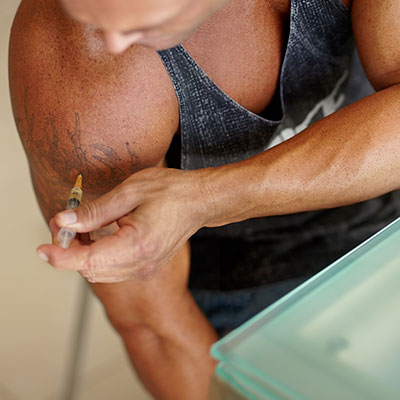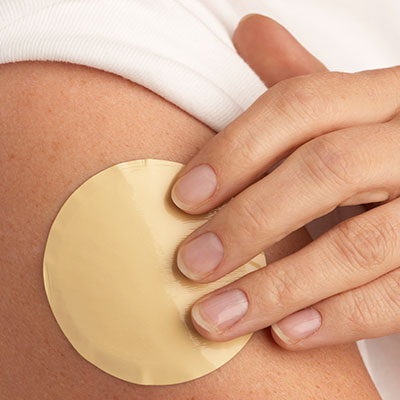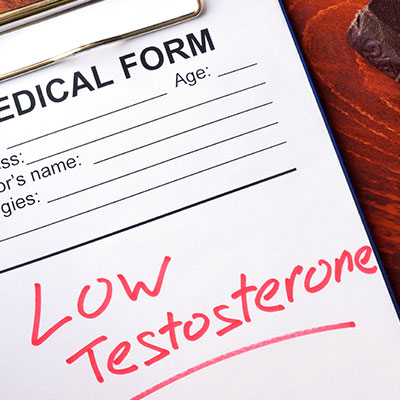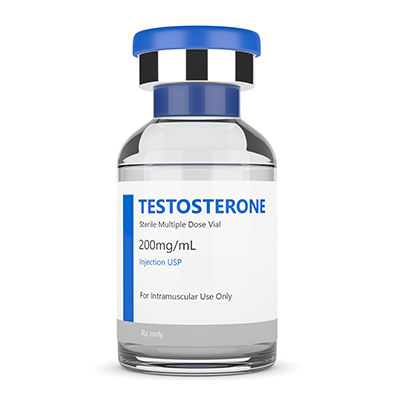What Is Testosterone Replacement Therapy, and Is It Right For You?
Contents
- Introduction to Testosterone Replacement Therapy
- Why Does Testosterone Decrease With Age?
- Benefits And Risks of Testosterone Therapy
- Benefits
- Risks
- Is Testosterone Replacement Therapy Safe?
- Who Uses Testosterone Replacement Therapy?
- Precautions and Contraindications for Testosterone Replacement Therapy*
- Warnings and Contraindications*
- Testosterone Replacement Therapy
- How Is Testosterone Administered?
- Injectable Testosterone
- Transdermal Testosterone Patches
- Oral Testosterone
Testosterone replacement therapy is a doctor-prescribed, clinically proven method to treat men and women with low testosterone.
Although technically a “male” hormone, testosterone is vital to the health and well-being of both men and women. Despite the important role that testosterone plays in strength, energy, vitality, and sexual wellness, testosterone levels dwindle as you age. This can result in low testosterone, a condition sometimes simply referred to as “Low T.”
Low testosterone can be a problem in women as well as men. Sometimes testosterone therapy is prescribed along with an entire hormone replacement therapy treatment plan for women dealing with hormone imbalances or menopausal symptoms. However, because the problem with age-related testosterone loss is predominantly faced by most men between the ages of 35 and 65, the information about testosterone replacement therapies discussed on these pages mainly applies to the treatment of men who have been diagnosed with low testosterone.
For such men, testosterone replacement therapy has been shown to have many life-changing benefits.
Introduction to Testosterone Replacement Therapy
Low testosterone in men is known by a few names. It is sometimes referred to as “low testosterone,” “Low-T,” or the more technical term “andropause.” But, no matter what you call it, testosterone injections can be used to very effectively counteract the steady drop in testosterone production that occurs as men age.
Why Does Testosterone Decrease With Age?

In men, testosterone is produced in the testes. Any disease, injury, or condition that impacts the function of the testes can lead to a testosterone deficiency. However, the most common cause of low testosterone in men is the normal drop in testosterone levels that occurs as men age.
A man’s testosterone level ramps up at puberty and continues to increase through the teen years, peaking about the age of 20. After that, it starts a steady decline. Once a man is in his 60s, his testosterone level is about half of what it was in his 20s. It is this age-related testosterone deficiency that is the most common testosterone deficiency in men requiring treatment with testosterone replacement therapy.
Benefits And Risks of Testosterone Therapy
For patients suffering from age-related low testosterone, testosterone replacement therapy has a wealth of benefits. Still, like any prescription medication or medical procedure, it is not without some risks. However, for most people diagnosed with low testosterone, the benefits of testosterone replacement therapy far out way its potential risks.
Benefits
For men that have been diagnosed with low testosterone, testosterone replacement therapy can have many astounding benefits. Once you have been on testosterone replacement for a few months, you can expect many improvements to your physical health and emotional well-being, with little or no side effects.
The benefits you can expect from testosterone replacement include:
- Increased strength
- Increased stamina
- More energy
- Improved sexual performance
- Increased ability to burn fat and build muscle
- Healthier skin and bones
- Improved performance in the gym
- Increased lean muscle mass
- Increased assertiveness and confidence
- Better recovery from workouts and injuries
Risks
Testosterone therapy, when properly prescribed, is generally safe and poses very little risk. The key to minimizing any risk and maximizing the benefits of testosterone replacement is to work with experienced doctors and to carefully follow all of your doctor’s instructions as to how to administer your testosterone replacement therapy.
However, that having all been said, testosterone replacement therapy is not entirely risk-free. Some of the reported possible, though rare, side effects of testosterone injections include:
- Increase risk of blood clots
- Enlarged breasts
- Increased risk of sleep apnea
- Acne
- Hair growth or premature puberty in girls or women who come into contact with gels or patches.
This is by no means the entire list, and it is not meant to scare you. In reality, most testosterone replacement patients have an incredibly positive experience and run the course of their testosterone replacement program with little or no side effects.
One way that our clinic tries to minimize any possible side effects of testosterone is by customizing your testosterone therapy treatment plan to your unique needs and lifestyle.
Testosterone therapy is designed to make up for the testosterone that you lose as you age.
Is Testosterone Replacement Therapy Safe?
Prescription testosterone medications are approved by the FDA for the treatment of low testosterone. All of the types and brands of prescription testosterone mentioned on these pages are generally regarded as safe. However, like any drug or medication, testosterone replacement therapy does have some reported, yet rare, side effects and associated risks.
Understand that most of the “horror stories” you hear about “taking testosterone” occur in men who are using testosterone illegally, abusing testosterone to enhance athletic performance, or have purchased testosterone without a doctor’s prescription on the “black market.”
When it is used as legitimately prescribed for men diagnosed with low testosterone, most if not all of the possible side effects of testosterone replacement are quite rare, and testosterone therapy is generally regarded as a safe and effective way to treat men suffering from a testosterone deficiency.
Who Uses Testosterone Replacement Therapy?

Medical professionals describe a testosterone deficiency as any condition that can cause your body to produce insufficient amounts of testosterone. This can be a problem because testosterone is a major hormone that regulates or influences many of the bodily processes that keep you strong and vital.
Testosterone levels are measured in nanograms per deciliter (ng/dL). Typically, the normal range is 300 to 1,000 ng/dL. Anything below 300 ng/dL is considered low testosterone.
Doctors who treat low testosterone recognize two types of testosterone deficiencies: primary and secondary testosterone deficiency. Often primary and secondary testosterone deficiency occur together.
- Primary Testosterone Deficiency – When you have a primary testosterone deficiency, that means that you don’t have enough testosterone due to a problem in the organs that make testosterone.
- Secondary Testosterone Deficiency – In a secondary testosterone deficiency, there is a problem in the areas of the brain that signal the sex organs to make or release testosterone.
In men, low testosterone is a condition in which the testes do not produce enough testosterone. There are several diseases and conditions that can cause low testosterone. Genetic disorders, some forms of cancer, or injury to the testes, can all cause low testosterone, also known as Low-t. However, the most common cause of low testosterone in men requiring testosterone replacement is age-related testosterone loss.
As you grow older, your levels of testosterone decline. This natural decline starts after age 30 and continues at a rate of about 1% to 2% per year throughout your life. By the time you are over 40, most men will be feeling the negative impacts of low testosterone.
However, testosterone replacement therapy is designed to bring the testosterone in your bloodstream back to more optimal levels.
Precautions and Contraindications for Testosterone Replacement Therapy*
While prescription testosterone replacement is generally regarded as safe, there are some people for whom it is not recommended. Here are some of the precautions and contraindications for testosterone replacement as per the prescribing information provided by the major manufacturers of prescription testosterone products.
According to the prescribing information for the most popular forms of testosterone therapy, prescription testosterone should not be used:
- In patients with a known hypersensitivity or allergy to the drug
- In males with carcinoma of the breast
- In males with known or suspected carcinoma of the prostate gland
- In women who are pregnant or may become pregnant
- In patients with serious cardiac, hepatic, or renal disease
Warnings and Contraindications*
Before accepting a prescription for any kind of testosterone therapy, tell your doctor if you have a medical history of:
- Cancer (such as breast cancer in men, prostate cancer)
- Blood clots (such as in the leg, lungs)
- Heart disease (such as heart failure, chest pain, heart attack)
- Stroke
- Liver problems
- Kidney problems
- High cholesterol
- High blood pressure
- Enlarged prostate
- Sleep apnea
- Diabetes.
In addition, tell your healthcare provider about any medicines you are taking, including prescription and over-the-counter medicines, vitamins, and herbal supplements. Prescription testosterone may affect how other medicines work, and other medicines may affect how testosterone therapy works.
See your medication’s insert for a complete list of potential drug interactions and other warnings regarding the use of prescription testosterone.
Testosterone Replacement Therapy
Conditions
Hypogonadism: Hypogonadism is classified as primary, secondary, or mixed. In males, primary hypogonadism results from dysfunction of the testes; secondary hypogonadism results from dysfunction of the pituitary of hypothalamus. See table for a summary of laboratory values, causes, and symptoms of hypogonadism. Although there is no universal laboratory definition of hypogonadism, most laboratory reference ranges for males report total testosterone concentrations <300 ng/dL as diagnostic, with a reference range of 300 ng/dL to 1,000 ng/dL.
Hypogonadism in Men
| Type | Laboratory Values | Causes | Symptoms |
|---|---|---|---|
| Primary | ↓ Serum Testosterone ↑ LH ↑ FSH | Chromosomal abnormalities, FSH/LH receptor mutations, chemotherapy, hypothyroidism | Reduced libido, ED, alopecia, infertility, pathological fracture, depressed mood, fatigue, reduced muscle mass, sleep disturbance, increased body fat, IDA |
| Secondary | ↓ Serum Testosterone N/↓ LH N/↓ FSH | Genetic abnormalities, chronic opioid use, hyperprolactinemia, pituitary tumors, trauma | |
| Mixed | ↓ Serum Testosterone Variable LH Variable FSH | Aging, cancer, DM, chronic glucocorticoid use, COPD, CKD, HIV/AIDS, obesity |
↓: decreased; ↑: increased; CKD: chronic kidney disease; COPD: chronic obstructive pulmonary disease; DM: diabetes mellitus; ED: erecticle dysfunction; FSH: follicle-stimulating hormone; IDA: iron-deficiency anemia; LH: luteinizing hormone; N: normal.
How Is Testosterone Administered?
Testosterone therapy can be given in skin patches, topical gels, or intramuscular injections. Most testosterone doctors agree that injections are the most effective method for administering T-therapy.
Testosterone therapy is usually initially prescribed for six months to one year. After that time, you will be reevaluated to determine if you need to continue testosterone therapy.
Injectable Testosterone

Injectable testosterone that is used for testosterone replacement therapy is available in several forms and sold under a variety of brand names. Injectable testosterone is usually prescribed as testosterone enanthate, testosterone cypionate, or testosterone propionate. All are what are known as testosterone esters. Esterification is a chemical process that makes testosterone more soluble and, therefore, injectable.
- Testosterone Enanthate – Testosterone enanthate tends to stay in the blood for about four to five days. Testosterone Enanthate is given as an intramuscular injection, usually every five to seven days.
- Testosterone Cypionate – Testosterone cypionate is considered to be a “longer-acting” testosterone than enanthate. It tends to take seven to eight days to be fully metabolized. Cypionate is often begun with a starting dose similar to enanthate, but since it lasts longer, it is only administered every seven days.
- Testosterone Propionate – Of the three types, testosterone propionate is considered to be the “fastest acting.” Testosterone propionate has been known to peak in the blood within hours of being injected. It can be metabolized in as little as three days. Testosterone propionate injections should be administered every two to three days.
Of the three types of testosterone discussed on this page, testosterone cypionate is the most commonly prescribed. The most popular brand of testosterone cypionate is Depo-Testosterone. It is more commonly known as “Depo.” Depo was the first testosterone injectable approved by the FDA. It has been produced by Pharmacia and Upjohn since 1979.
Depo-testosterone is available in two strengths, 100 mg and 200 mg.
Other brands of testosterone injections include:
- Delatestryl (testosterone enanthate, made by Endo Pharmaceuticals, Inc.)
- Aveed (testosterone undecanoate, made by Endo Pharmaceuticals, Inc.)
- Xyosted (testosterone enanthate, made by Antares Pharma, Inc. )
- Virormone (testosterone propionate, made by Nordic Pharma )
Our doctors believe that for most patients, testosterone injections are the preferred form of testosterone replacement therapy. This is for two main reasons; one, it is the fastest-acting and most effective way to raise your testosterone because it is injected directly into your bloodstream. And, two, there is such a wide variety of doses and types of injectable testosterone available that there is bound to be one that fits your symptoms, goals, and lifestyle. In addition, because of this variety, in the rare event that you have any side effects, they can usually be mitigated by simply changing your dose or brand of testosterone injection.
Regardless of the brand or type of testosterone injection, all testosterone injections have the same benefits and the same risks.
Transdermal Testosterone Patches

The most popular testosterone patch is sold under the brand names Androderm or Androplex.
In this type of testosterone replacement, a patch containing testosterone is applied each night to your thighs or torso. In addition to the same possible side effects as all forms of testosterone therapy, with the skin patch, there is the possibility of a severe skin reaction.
Another limitation of patches is that they are available only in limited doses, and others – especially women and pregnant can be in severe danger of coming into contact with the path of clothing that was worn next to the patch. Therefore patches are almost always recommended only for men who have little or no risk of coming into contact with children.
Oral Testosterone
Recently, several pharmaceutical manufacturers have introduced oral forms of testosterone replacement drugs.
Oral testosterone medications (which includes pills, nasal sprays, and those applied to the gums) may include:
- Metandren
- Virilon
- Testred
- Natesto
This option reduces the risk that medication will be transferred to another person through skin contact as in a patch, but nasal-delivered testosterone must be applied twice in each nostril, three times daily, which might be more inconvenient than other delivery methods. And, all forms of “oral” testosterone-like testosterone patches – are available in far fewer dosage options than testosterone injections.
Testosterone therapy is a clinically proven, safe, and effective way to treat age-related testosterone loss.
Now that you know a lot more about testosterone replacement therapies, why not contact us today and learn more about the many life-changing benefits of testosterone replacement.
*Prescribing information, warnings, side effects, and contraindications are provided for informational purposes only and should not be construed as any kind of instructions for use or exposure to risk. Consult your physician or pharmacist for guidance regarding the potential risks of your particular dose of prescription testosterone.
FAQ
What will testosterone therapy do for me?
Testosterone replacement therapy does exactly what you might imagine from the name. Prescription testosterone drugs replace or make up for the volume of testosterone that you may be lacking.
By optimizing your testosterone level, you will feel and look younger and stronger in four major areas of your life:
- Sexually
- Physically
- Emotionally
- Cognitively
What is the best testosterone treatment?
The most effective kind of testosterone medications are those that use bioidentical hormones. Bioidentical hormones are exact copies of the chemical level of the hormones normally produced by your body. So, when the testosterone receptor sites interact with the testosterone that is introduced to your bloodstream via a testosterone patch, cream, pill, or injection, they react to it the same way as they would to your naturally produced testosterone.
How long does it take to feel the effects of testosterone therapy?
When it comes to how fast you can expect testosterone therapy to work, you must have patience. The idea behind testosterone replacement therapy, and in particular, testosterone injections, is to accumulate benefits slowly over time.
For men that have been suffering the impact of low testosterone, it is necessary that we introduce your system to increased testosterone a little at a time. This allows your body and your entire system to adapt correctly to the increased presence of testosterone in the blood. Doing so any other way could throw off the delicate balance of all of your hormones and do more harm than good.
This all having been said, do not take that to mean that you have to wait an awfully long time for your testosterone injections to work. Most men start to see improvements within the very first weeks of taking testosterone injections.
Does insurance cover testosterone therapy?
In most cases, the cost of your actual testosterone medication (injection, pill, patch, etc.) is not covered by insurance. However, your health insurance may reduce the overall cost of your testosterone therapy by paying for some aspects of your testosterone treatment plan, such as lab work or doctor's visits. If you do have medical insurance, it is best to check with your particular provider for the specifics of your coverage for testosterone replacement therapy.
At what age should you start testosterone therapy?
As you age, your testosterone level naturally declines. Once you are over 30, the decline in testosterone can lead to a number of debilitating conditions that collectively are known as “low testosterone,” "male menopause," or “andropause.” Unlike menopause in women, which is triggered by a specific time in life when menstruation ends, andropause in men can begin almost any time after the age of 30 and is not linked to any one symptom or biological condition.
Therefore, the best time to start testosterone therapy is as soon as you are feeling the symptoms of low T. The signs and symptoms of low testosterone in men include:
- Weight gain, even when eating right and exercising
- Muscle loss
- Fatigue and weakness
- Poor sleep
- Sexual health issues
- Foggy thinking or other cognitive issues
- Irritability, mood swings, and/or depression
Even when you have found the right kind of doctor to evaluate your symptoms, do not expect him or her to immediately start you on testosterone therapy.
Prescriptions for testosterone therapy are not written lightly by ethical doctors. Before you are given testosterone therapy, any legitimate doctor will need to take a complete medical history and physical exam, which will then be followed by a specialized blood test to check for your testosterone levels. If your testosterone blood tests indicate that you indeed have low testosterone, then it will be time to start testosterone therapy.
How can I test my testosterone levels at home? (need to find this)
There are some "home testing" kits for testosterone levels available from a variety of manufacturers. However, all of these "home testosterone test kits" rely on saliva to assess your testosterone level. Such a home test is not nearly as accurate as a full blood test. Our doctors only use blood tests sent to reliable labs such as Quest and LabCorp to do our testosterone testing.
Even if low testosterone has been indicated by a home test kit, your doctor will still do a blood test before issuing you a diagnosis of low testosterone and providing you with a prescription for low testosterone.
Remember, you can only legitimately buy testosterone with a doctor's prescription. "Self-diagnosis" of low testosterone with a home kit and then purchasing testosterone without a doctor's prescription is not only illegal, but it could also be hazardous to your health.
What kind of benefits can I expect from treatment for low testosterone?
If you have been diagnosed with low testosterone and prescribed testosterone replacement therapy, you can expect many life-changing benefits. For men with age-related low testosterone, taking prescription testosterone medication has been shown to:
- Increase energy and vitality
- Improve libido and sexual function
- Improve cognition and focus
- Help you to build more lean muscle and burn fat
- Improve sleep
- Combat depression and anxiety
Many men who have been on testosterone medication say that it has been a life-changing experience and that it has helped them to "get back their edge."
- Nazem Bassil, MD., Saad Alkaade, MD., John E Morley, MD.
- Geoffrey Hackett, MD., FRCPI., MRCGP., FECSM.
- Huanguang Jia, MPH., PhD., Charles T Sullivan, MD., Sean C McCoy, PhD., Joshua F Yarrow, PhD., Matthew Morrow, Stephen E Borst, PhD.
- U.S. National Library of Medicine
- Harvard Health Publishing
The benefits and risks of testosterone replacement therapy: a review
An update on the role of Testosterone replacement therapy in the management of hypogonadism
Review of health risks of low testosterone and testosterone administration
A Study in Men With Low Testosterone to Measure the Effects of Testosterone Solution on Testosterone Levels, Sex Drive and Energy
Is testosterone therapy safe? Take a breath before you take the plunge




